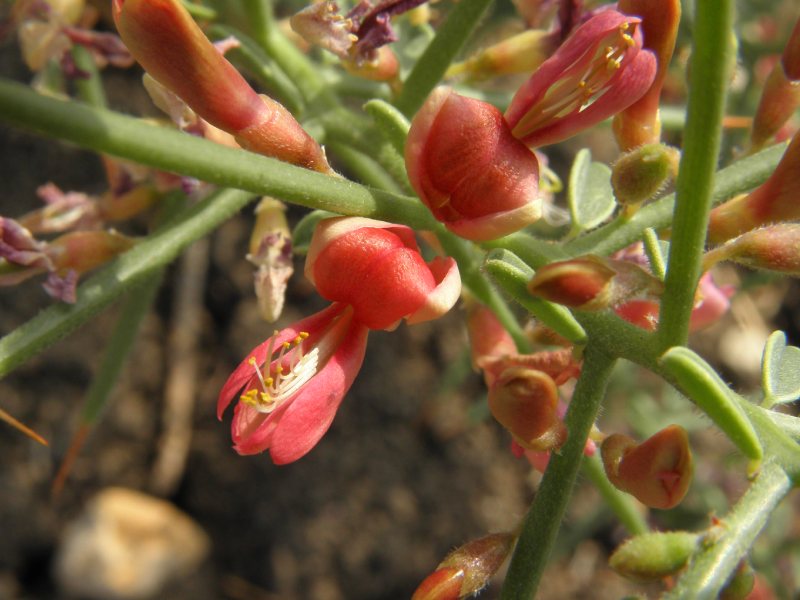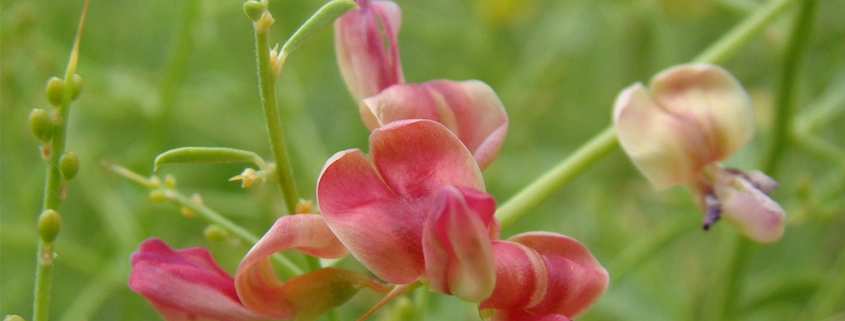Alhagi Plants (Location, Benefits, Uses)
Alhagi, which is known by different names around the world, is known as a medicinal plant with extremely beneficial properties. It has been proven that many diseases have been cured by taking Alhaji. This plant, also known as Adore (scientific name Alhagi maurorum), is a perennial plant of the legume family (Fabaceae), which specifically belongs to the subfamily Faboideae. Another name for it is “Adverturf.”
The fruit of this plant is non-fleshy. Its bushes are semi-woody and can reach heights of 50 to 150 centimeters. Its stems are greenish with sharp yellow-tipped thorns. Alhagi is known for its diuretic, anti-cough, and antipyretic properties. Its leaves are smooth and bell-shaped and have five triangular teeth with short tips.
In the next parts, we will learn about the history, properties, and methods of Alhaji reproduction.
What is the Significance of Alhagi Maurorum?
Alhagi Maurorum has considerable cultural, medicinal, and ecological importance. This plant is native to parts of Africa, Asia, and Europe and has been used in traditional medicine for centuries, especially in the treatment of various diseases such as digestive problems, respiratory problems, and skin diseases.
In addition, it plays an important role in the ecosystem by stabilizing the soil, preventing erosion, and providing food and shelter for wildlife, especially in the arid and semi-arid regions where it grows.
Also, in some cultures, Alhagi Maurorum has symbolic significance, representing the resilience, adaptability, and enduring bond between humans and nature.
However, it is important to note that while it provides countless benefits, it can be invasive in certain environments and pose challenges to native flora and fauna. Therefore, its importance emphasizes the complex relationship between humans, plants, and the environment and highlights the need for sustainable management practices.
What is the Common Name of Alhagi Persarum?
The common name of Alhagi persarum is Persian camelthorn. This plant is part of the Alhagi genus and is native to regions such as Iran and surrounding areas. Similar to other species within the Alhagi genus, Persian camelthorn is known for its hardiness and ability to thrive in arid and semi-arid climates.
It typically grows in sandy soils and is characterized by its thorny branches and small, pink to purple flowers. In various cultures, Alhagi persarum holds significance both medicinally and ecologically, showcasing its importance in local ecosystems and traditional medicine practices.
Where Can I Find Alhagi?
Alhagi can be found in arid and semi-arid regions around the world, especially in sandy soils and arid climates. This plant grows in areas with low rainfall and high temperatures, which makes it suitable for deserts, steppes, and other similar environments.

You may come across Alhagi growing along roadsides, in pastures, or in disturbed land. Its ability to tolerate harsh conditions and its invasive nature means that it can sometimes be found rapidly expanding in areas where it has been introduced.
Where Do Alhagi Plants Grow?
Alhagi, also known as camel thorn, originates from regions such as Russia, South Africa, Western Asia, and the Mediterranean. This plant grows in various weather conditions and is very resistant to cold and soil salinity. Its lifespan is several years, and it can grow in different types of soil even in salt marshes.
Alhagi also grows in other regions, such as the deserts of Iran, Saudi Arabia, India, Pakistan, and Syria. In Iran, it grows naturally in areas, such as Baluchistan, Khuzestan, Semnan, Kermanshah, Bojnourd, Ahvaz, Shiraz, Bandar Abbas, Qeshm, and Khorasan. Alhagi has many medicinal properties, including antiseptic, blood coagulant, antipyretic, anti-inflammatory, liver regenerator, and cleanser.
Alhagi Maurorum Benefits
Alhagi maurorum, a herbaceous plant found in many regions worldwide, contains a variety of beneficial compounds and elements that can contribute to human health. Here are some important elements and compounds found in the Alhagi maurorum plant:
1. Vitamins: Alhagi maurorum is rich in essential vitamins such as vitamin C, vitamin A, vitamin K, and vitamin E. These vitamins can support immune function, skin health, eye health, and inflammatory processes.
2. Minerals: Alhagi maurorum is abundant in important minerals like iron, calcium, magnesium, and potassium. These minerals are essential for maintaining bone health, muscle function, healthy blood pressure, and regulating water and electrolyte balance in the body.
3. Phytochemicals: Alhagi maurorum contains flavonoids, carotenoids, phytoestrogens, and tannins. These active compounds possess antioxidant power and can help combat oxidative damage, inflammation, and cardiovascular health issues.
4. Essential Fatty Acids: Alhagi maurorum seeds contain essential fatty acids such as linoleic acid (Omega-6) and linolenic acid (Omega-3). These fatty acids can support heart and brain health and reduce inflammation.
5. Amino Acids: Alhagi maurorum contains essential and non-essential amino acids that play a vital role in building and repairing body tissues.
Characteristics of Alhagi Maurorum
Shape and Appearance: Alhagi maurorum can grow up to 2 meters tall and has perennial stems that grow vertically over time. Its leaves have a dark green surface and are usually covered with small, sharp thorns and spines. In case of contact with human skin, they can cause temporary irritation and itching.

Types: Alhagi maurorum is divided into two types male and female. Male and female flowers of Alhagi maurorum are distinct from each other and are located on separate stems. Male flowers are long and contain pollen, while female flowers are smaller and bear fruit.
Alhagi Maurorum Medicinal Uses
Alhagi maurorum is used in traditional and folk medicine for treating and preventing various diseases. This plant is often valued as a herbal remedy and supplement. Below are some of the conditions where Alhagi maurorum may be beneficial for treatment and prevention:
1. Joint Inflammation: Alhagi maurorum is commonly used to alleviate symptoms of joint inflammation, such as lower back pain, arthritis, and joint trauma. Its anti-inflammatory effects may help relieve pain, swelling, and stiffness in joints.
2. Skin Diseases: Alhagi maurorum is used as a complementary treatment for certain skin conditions like dermatitis, psoriasis, and acne. Its anti-inflammatory and antibacterial properties can aid in improving skin symptoms.
3. Allergies: Alhagi maurorum may be helpful in alleviating symptoms of allergies such as hay fever and food allergies. Its precise mechanism involves reducing inflammatory reactions and histamine release from allergic cells.
4. Digestive Disorders: Some individuals may use Alhagi maurorum to help with gastrointestinal issues like irritable bowel syndrome (IBS) symptoms, constipation, and relieving symptoms of intestinal inflammation (such as colitis).
5. Urinary and Kidney Disorders: Some research suggests that Alhagi maurorum may be effective in improving conditions such as urinary tract inflammation, kidney stones, and urinary retention.
6. Neuromotor Disorders: Some studies have shown that Alhagi maurorum can help improve symptoms of neuromotor disorders such as restless legs syndrome and hand tremors.
Alhagi Maurorum Uses
1. Calmness and Stress Reduction: Alhagi maurorum is known as a calming herb and can help reduce stress and anxiety, improving overall body and mind relaxation.
2. Improving Sleep: Alhagi maurorum can promote restful sleep and enhance sleep quality, aiding in alleviating sleep problems such as insomnia.
3. Reducing Restlessness and Nervous Anxiety: Consumption of Alhagi maurorum may be effective in reducing symptoms of restlessness and nervous anxiety often associated with inadequate sleep.
Final Word
With its rich history, diverse uses, and considerable medicinal and ecological importance, Alhagi stands as a remarkable plant in the botanical world. From its traditional medicinal uses to its role in supporting biodiversity and soil stabilization, Alhagi maurorum is an example of the complex relationship between humans and nature.
Whether it is to reduce joint inflammation, relieve skin conditions, or promote relaxation and better sleep. However, it is necessary to balance its medicinal uses with conservation efforts to reduce its aggressive tendencies.
By understanding and using Alhagi’s potential responsibly, we can continue to appreciate its value and contribution to human well-being and environmental harmony.
Are you planning to travel to Iran and looking for an Iran resort? Consider Matinabad Eco-resort.





Leave a Reply
Want to join the discussion?Feel free to contribute!